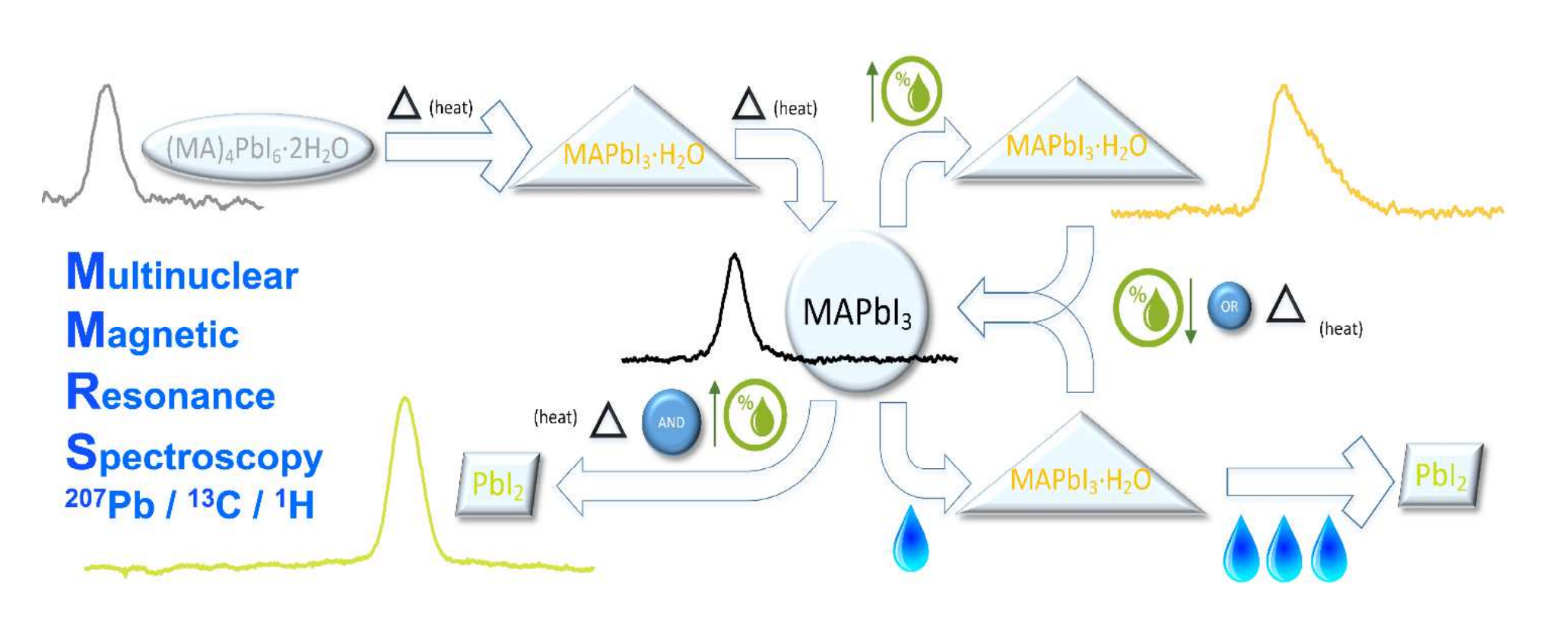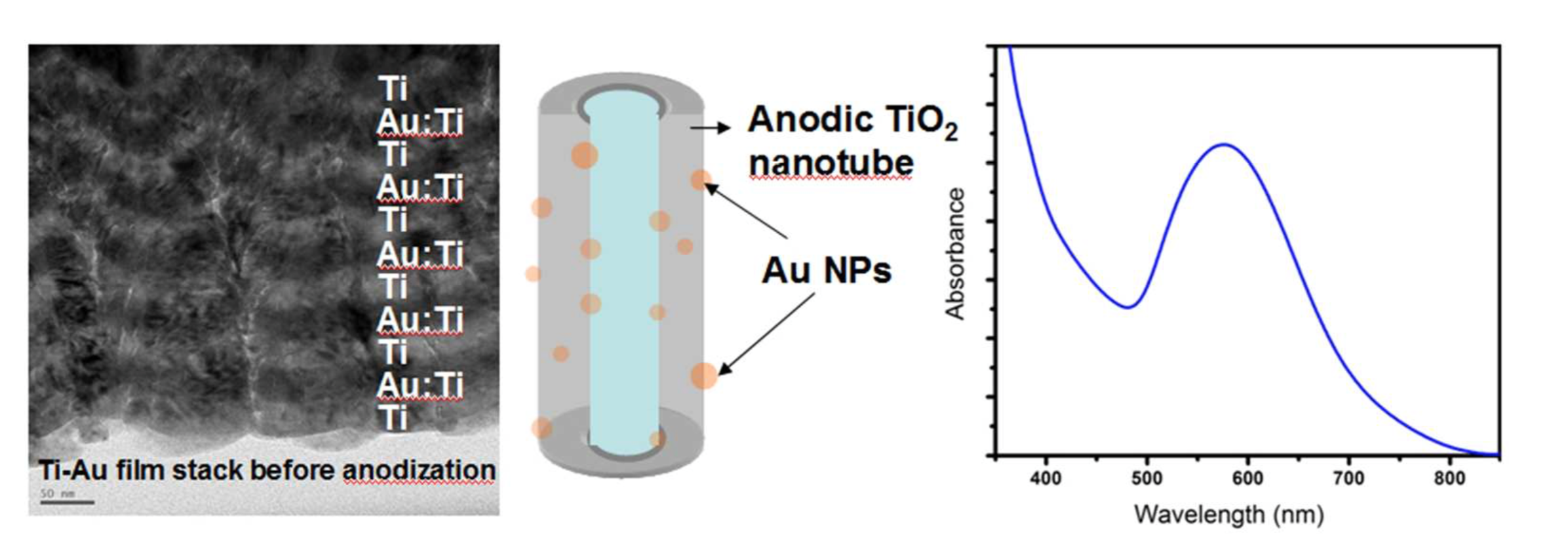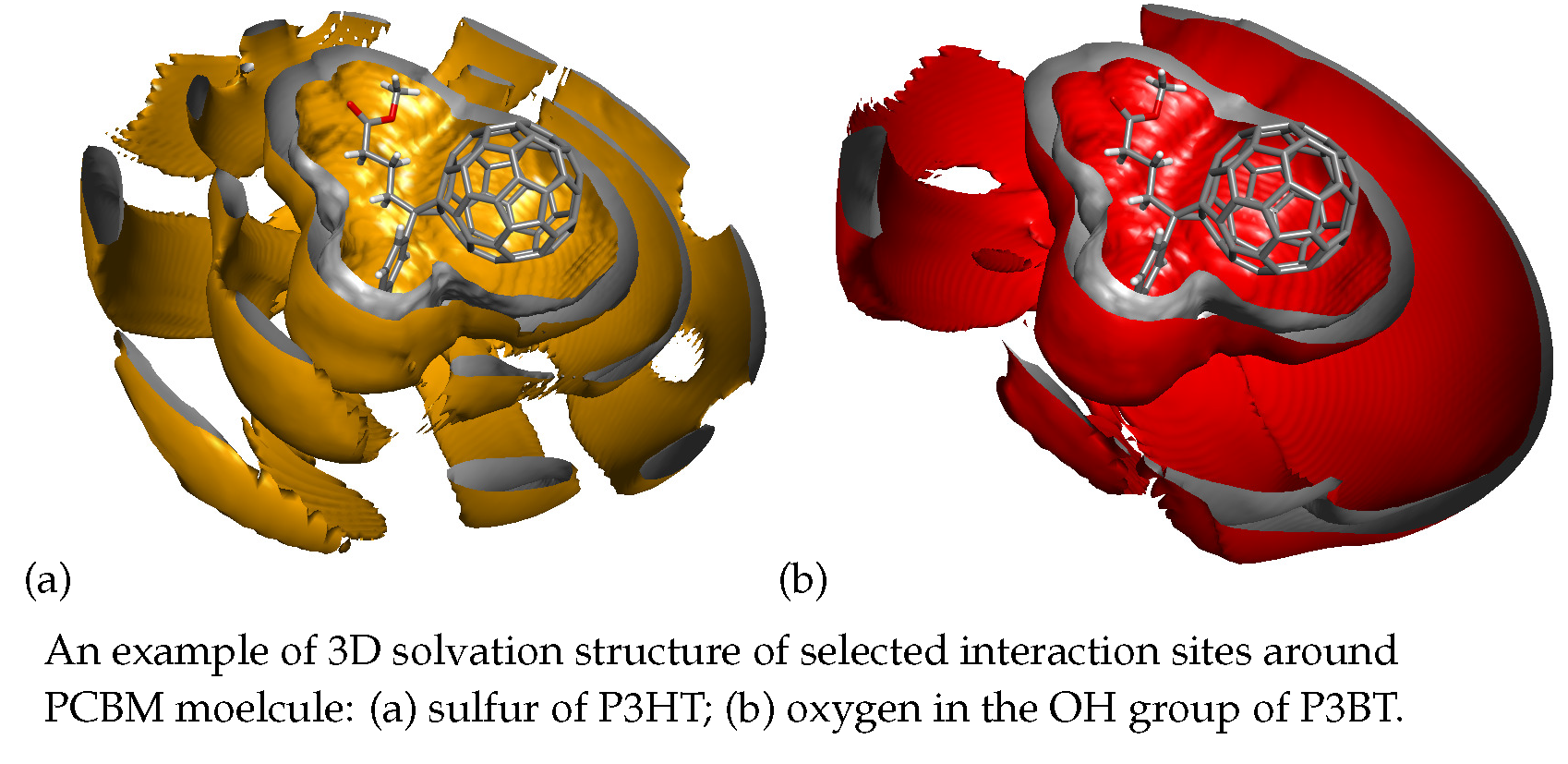2016
79. Askar AM, Bernard GM, Wiltshire BD, Shankar K and Michaelis VK, Multinuclear Magnetic Resonance Tracking of Hydro, Thermal and Hydrothermal Decomposition of CH3NH3PbI3, Journal of Physical Chemistry C, (published online Dec 15, 2016), DOI: 10.1021/acs.jpcc.6b10865.

Abstract: An NMR investigation of methylammonium lead iodide, the leading member of the hybrid organic-inorganic perovskite class of materials, and of its putative decomposition products as a result of exposure to heat and humidity, has been undertaken. We show that the 207Pb NMR spectra of the compound of interest and of the proposed lead-containing decomposition products, CH3NH3PbI3∙H2O, (CH3NH3)4PbI6∙2H2O and PbI2, have distinctive chemical shifts spanning over 1400 ppm, making 207Pb NMR an ideal tool for investigating this material; further information may be gained from 13C and 1H NMR spectra. As reported in many investigations of CH3NH3PbI3 on films, the bulk material hydrates in the presence of high relative humidity (approximately 80 %), yielding the monohydrated perovskite CH3NH3PbI3∙H2O. This reaction is reversible by heating the sample to 341 K. We show that neither the dihydrated perovskite nor PbI2 are observed as decomposition products and that, in contrast to many studies on CH3NH3PbI3 films, the bulk material does not decompose or degrade beyond CH3NH3PbI3∙H2O upon exposure to humidity at ambient temperature. However, exposing CH3NH3PbI3 concurrently to heat and humidity, or directly exposing it to liquid water, leads to the irreversible formation of PbI2. In spite of its absence among the decomposition products, the response of (CH3NH3)4PbI6∙2H2O to heat was also investigated. It is stable at temperatures below 336 K but then rapidly dehydrates, first to CH3NH3PbI3∙H2O, then to CH3NH3PbI3. The higher stability of the bulk material as reported here is a promising advance, since stability is a major concern in the development of commercial applications for this material.
78. Farsinezhad S, Banerjee S, Rajeeva BB, Wiltshire BD, Sharma H, Sura A, Mohammadpour A, Kar P, Fedosejevs R and Shankar K, Reduced ensemble plasmon linewidths and enhanced two-photon luminescence in anodically formed high surface area Au-TiO2 3D nanocomposites, ACS Applied Materials & Interfaces (accepted 11/29/16).

Abstract: Localized surface plasmon resonances (LSPR) in TiO2 nanorod and nanotube arrays decorated by gold nanoparticles can be exploited to improve photocatalytic activity, enhance non-linear optical coefficients and increase light harvesting in solar cells. However the LSPR typically has a low quality factor and the resonance is often obscured by the Urbach tail of the TiO2 band gap absorption. Attempts to increase the LSPR extinction intensity by increasing the density of gold nanoparticles on the surface of the TiO2 nanostructures invariably produce peak broadening due to the effects of either agglomeration or polydispersity. We present a new class of hybrid nanostructures containing gold nanoparticles (NPs) partially embedded in nanoporous/nanotubular TiO2 by performing the anodization of co-sputtered Ti-Au thin films containing a relatively high ratio of Au:Ti. Our method of anodizing thin film stacks containing alternate layers of Ti and TiAu results in very distinctive LSPR peaks with quality factors as high as 6.9 and ensemble linewidths as small as 0.33 eV even in the presence of an Urbach tail. Unusual features in the anodization of such films are observed and explained, including oscillatory current transients and the observation of coherent hetero-interfaces between the Au NPs and anatase TiO2. We further show that such a plasmonic NP-embedded nanotube structure dramatically outperforms a plasmonic NP-decorated anodic nanotube structure in terms of the extinction coefficient, and achieves a strongly enhanced two-photon fluorescence due to the high density of gold nanoparticles in the composite film and the plasmonic local field enhancement.
77.Hosseini A, Kar P, Hsieh LH, Wiltshire BD, Mohammadpour A, Farsinezhad S, Benlamri M, Zhang Y, Ercelebi C and Shankar K, "Radial Heterojunction Solar Cell Consisting of n-Type Rutile Nanowire Arrays Infiltrated by p-Type CdTe", Journal of Nanoscience and Nanotechnology (in press), 2017

76. Mohammadpour A, Wiltshire BD, Farsinezhad S, Zhang Y, Askar AM, Kisslinger R, Delgado WT, He G, Kar P, Rivard E and Shankar K, Charge Transport, Doping and Luminescence in Solution-Processed, Phosphorescent, Air-Stable Tellurophene Thin Films, Organic Electronics 39 153-162 2016.

Abstract: Recently synthesized small molecule tellurophenes containing ring-appended pinacolboronate (BPin) side groups possess remarkable guest-free air-stable solid-state phosphorescence, structure-based color-tunability and aggregation induced enhanced emission. The charge transport, doping and luminescence behavior of thin transparent films of a tellurophene with BPin groups positioned at the 2,5-positions (B-Te-6-B) was investigated. Film formation played a critical role in determining the hole mobility and the photoluminescence (PL) lifetime. Drop-coated films showed the strongest crystallinity, the highest PL quantum yields and a hole mobility (μp) of 1.1 × 10−4 cm2 V−1 s−1, which places tellurophenes in a select group of high mobility phosphorescent emitters. B-Te-6-B was also found to spontaneously form high aspect-ratio microwires upon drop-casting from supersaturated solutions. Oxidative doping in solution by a N(C6H4Br)3[SbCl6]/LiNTf2 reagent combination (Tf = SO2CF3) increased conductivity by 2-4 orders of magnitude without inducing a color change in the films, while exposure to iodine vapor induced a dramatic change in color together with a 4-6 order of magnitude change in the conductivity. The optical transparency, facile electrical doping and relatively high hole mobilities of B-Te-6-B in solution processed thin films offer promise for the use of tellurophenes as host-free emissive layers and hole transport layers in organic optoelectronic devices.
75. Boppella R, Mohammadpour A, Illa S, Farsinezhad S, Basak P, Shankar K and Manorama SV, Hierarchical Rutile TiO2 Aggregates: High Photonic Strength Material for Optical and Optoelectronic Devices, Acta Materialia 119 92-103 2016.

Abstract: Hierarchical monodisperse and poly-disperse rutile TiO2 aggregates featuring excellent light scattering properties were synthesized by a simple hydrolysis route at low temperature using sucrose as the structure directing agent. Various characterization techniques revealed that sucrose played a key role in controlling the shape and size distribution of hierarchical aggregates. The aggregates are formed by nano-sized crystallites and, therefore, are able to offer both a large specific surface area and strong light scattering behaviour. Films composed of monodisperse 465 nm rutile spheres coupled to a layer of commercial P25 anatase nanoparticles manifested a large photonic strength through the combination of a high haze ratio and a large back scattering-to-forward scattering ratio. The hierarchical rutile TiO2 aggregates when employed as the sole working electrode in DSSCs, achieved a 5.16% power conversion efficiency which is higher than that of commercial P25 (5.04%) with same thickness. In addition, the overall conversion efficiency of 7.26% was achieved when hierarchical aggregates were used as the light scattering overlayer of photoanode. The significant enhancement in overall conversion efficiency was attributed to the large photon absorption by increasing path length of photons due to the multiple scattering by hierarchical aggregates.
74. Kar P, Farsinezhad S, Mahdi N, Zhang Y, Obuekwe U, Sharma H, Shen J, Semagina N and Shankar K, Enhanced CH4 yield by photocatalytic CO2 reduction using TiO2 nanotube arrays grafted with Au, Ru and ZnPd nanoparticles, Nano Research (published online Aug 30, 2016), doi:10.1007/s12274-016-1225-4.

Abstract: Metal nanoparticle (NP) co-catalysts on metal oxide semiconductor supports are attracting attention as photocatalysts for a variety of chemical reactions. Related efforts seek to make and use Pt-free catalysts. In this regard, we report here enhanced CH4 formation rates of 25 and 60 μmol·g–1·h–1 by photocatalytic CO2 reduction using hitherto unused ZnPd NPs as well as Au and Ru NPs. The NPs are formed by colloidal synthesis and grafted onto short n-type anatase TiO2 nanotube arrays (TNAs), grown anodically on transparent glass substrates. The interfacial electric fields in the NP-grafted TiO2 nanotubes were probed by ultraviolet photoelectron spectroscopy (UPS). Au NP-grafted TiO2 nanotubes (Au-TNAs) showed no band bending, but a depletion region was detected in Ru NP-grafted TNAs (Ru-TNAs) and an accumulation layer was observed in ZnPd NP-grafted TNAs (ZnPd-TNAs). Temperature programmed desorption (TPD) experiments showed significantly greater CO2 adsorption on NP-grafted TNAs. TNAs with grafted NPs exhibit broader and more intense UV–visible absorption bands than bare TNAs. We found that CO2 photoreduction by nanoparticle-grafted TNAs was driven not only by ultraviolet photons with energies greater than the TiO2 band gap, but also by blue photons close to and below the anatase band edge. The enhanced rate of CO2 reduction is attributed to superior use of blue photons in the solar spectrum, excellent reactant adsorption, efficient charge transfer to adsorbates, and low recombination losses.
73. Zarifi MH, Farsinezhad S, Wiltshire BD, Abdorrazaghi M, Mahdi N, Kar P, Daneshmand M and Shankar K, Effect of Phosphonate Monolayer Adsorbate on the Microwave Photoresponse of TiO2 Nanotube Membranes Mounted on a Planar Double Ring Resonator, Nanotechnology 27, 375201, 2016.
Abstract: In this study, the effects of a phosphonate molecular monolayer adsorbed on the surface of a free-standing self-organized TiO2 nanotube membrane, on the microwave photoresponse of the membrane are presented. This phenomenon is monitored using planar microwave sensors. A double ring resonator is utilized to monitor the permittivity and conductivity variation on the monolayer coated membrane and the sensor environment separately. It is shown that the rise time and subsequent decay of the amplitude (A), resonance frequency (f 0) and quality factor (Q) of the resonator depend on the existence and the type of the monolayer coating the membrane. Three different monolayers of n-decylphosphonic acid (DPA), 1H, 1H', 2H, 2H'-perfluorodecyl phosphonic acid (PFDPA) and 16-phosphonohexadecanoic acid adsorbed on the titania nanotube membrane are investigated while monitoring their microwave properties during the illumination time period and in the relaxation period, which demonstrate different behavior in comparison to each other and to the bare nanotube membrane layer. The effect of humidity on the TiO2 nanotube membrane with and without different monolayers is also studied and the results demonstrate distinguishable microwave responses. While each of the monolayer-coated membranes exhibited an attenuation of the photo-induced change in A, f 0 and Q with respect to the bare membrane, PFDPA-coated membranes showed the smallest relative change in the monitored microwave parameters upon ultraviolet illumination and upon the introduction of different levels of humidity. These effects are explained on the basis of surface trap passivation by the monolayers as well as the hydrophobicity of the monolayers. Our work also shows how the interactions of self-assembled monolayers with charge carriers and surface states on metal oxides may be used to indirectly sense their presence through measurement of the microwave response.
72. Mohammadpour A, Eltahlawy M, Martino A, Askar AM, Kisslinger R, Fedosejevs R and Shankar K, "Optical limiting in Cu/CuO nanostructures formed by magnetic field-assisted anodization", Journal of Nanoscience and Nanotechnology (in press), 2016.
71. Farsinezhad S, Mohammadpour A, Benlamri M, Dalrymple A and Shankar K, "The morphology of TiO2 nanotube arrays grown from atomically peened and non-atomically peened Ti films", Journal of Nanoscience and Nanotechnology (in press), 2016.
70. Benlamri M, Farsinezhad S, Barlage DW and Shankar K, High performance electrodeposited ZnO thin films on flexible substrates, ECS Journal of Solid State Science and Technology, 5(6), P324-P326, 2016.
Abstract: We report the fabrication of Cu/ZnO Schottky diodes on flexible polyimide substrates that can retain high performance under substrate bending. The ZnO films are synthesized with an optimized low-cost electrodeposition technique on a thin copper (Cu) film adhered to a flexible Kapton substrate via a titanium (Ti) adhesion layer. The Cu/ZnO system constituted a Schottky diode that demonstrated rectification ratios of ∼106 and ideality factors of ∼2 to 3, which surpass the current state-of-the-art for solution-processed ZnO films.
69. Kobryn AE, Gusarov S and Shankar K, The Effect of Molecular Structure and Environment on the Miscibility and Diffusivity in Polythiophene- Methanofullerene Bulk Heterojunctions: Theory and Modeling with the RISM Approach, Polymers, 8(4), 136-151, 2016.

Abstract: Although better means to model the properties of bulk heterojunction molecular blends are much needed in the field of organic optoelectronics, only a small subset of methods based on molecular dynamics- and Monte Carlo-based approaches have been hitherto employed to guide or replace empirical characterization and testing. Here, we present the first use of the integral equation theory of molecular liquids in modelling the structural properties of blends of phenyl-C61-butyric acid methyl ester (PCBM) with poly(3-hexylthiophene) (P3HT) and a carboxylated poly(3-butylthiophene) (P3BT), respectively. For this, we use the Reference Interaction Site Model (RISM) with the Universal Force Field (UFF) to compute the microscopic structure of blends and obtain insight into the miscibility of its components. Input parameters for RISM, such as optimized molecular geometries and charge distribution of interaction sites, are derived by the Density Functional Theory (DFT) methods. We also run Molecular Dynamics (MD) simulation to compare the diffusivity of the PCBM in binary blends with P3HT and P3BT, respectively. A remarkably good agreement with available experimental data and results of alternative modelling/simulation is observed for PCBM in the P3HT system. We interpret this as a step in the validation of the use of our approach for organic photovoltaics and support of its results for new systems that do not have reference data for comparison or calibration. In particular, for the less-studied P3BT, our results show that expectations about its performance in binary blends with PCBM may be overestimated, as it does not demonstrate the required level of miscibility and short-range structural organization. In addition, the simulated mobility of PCBM in P3BT is somewhat higher than what is expected for polymer blends and falls into a range typical for fluids. The significance of our predictive multi-scale modelling lies in the insights it offers into nanoscale morphology and charge transport behaviour in multi-component organic semiconductor blends.
68. Askar AM and Shankar K, Exciton Binding Energy in Organic-Inorganic Tri-Halide Perovskites, Journal of Nanoscience and Nanotechnology, 16(6), 5890-5901, 2016.
Abstract: The recent dramatic increase in the power conversion efficiencies of organic–inorganic tri-halide perovskite solar cells has triggered intense research worldwide and created a paradigm shift in the photovoltaics field. It is crucial to develop a solid understanding of the photophysical processes underlying solar cell operation in order to both further improve the photovoltaic performance of perovskite solar cells as well as to exploit the broader optoelectronic applications of the tri-halide perovskites. In this short review, we summarize the main research findings about the binding energy of excitons in tri-halide perovskite materials and find that a value in the range of 2–22 meV at room temperature would be a safe estimate. Spontaneous free carrier generation is the dominant process taking place directly after photoexcitation in organic–inorganic tri-halide perovskites at room temperature, which eliminates the exciton diffusion bottleneck present in organic solar cells and constitutes a major contributing factor to the high photovoltaic performance of this material.
67. Benlamri M, Farsinezhad S, Barlage DW and Shankar K, Low residual donor concentration and enhanced charge transport in low-cost electrodeposited ZnO, Journal of Materials Chemistry C, 4, 2279-2283, 2016.

Abstract: High unintentional n-type doping and poor charge transport are key limitations in solution processed ZnO thin films. In this context, we report ZnO films with a low residual donor concentration and high texture, synthesized by low-cost electrodeposition on copper. They possess an equilibrium free electron concentration of ∼2.8 × 1014 cm−3 and a minimum electron mobility of 80 cm2 V−1 s−1. The resulting Schottky diodes demonstrate rectification ratios of ∼106, ideality factors of ∼2, and low on-state resistance.
66. Zarifi MH, Farsinezhad S, Abdolrazzaghi M, Daneshmand M and Shankar K, Selective microwave sensors exploiting the interaction of analytes with trap states in TiO2 nanotube arrays, Nanoscale, 8, 7466-7473, 2016.

Abstract: Sensing of molecular analytes by probing the effects of their interaction with microwaves is emerging as a cheap, compact, label-free and highly sensitive detection and quantification technique. Microstrip ring-type resonators are particularly favored for this purpose due to their planar sensing geometry, electromagnetic field enhancements in the coupling gap and compatibility with established printed circuit board manufacturing. However, the lack of selectivity in what is essentially a permittivity-sensing method is an impediment to wider adoption and implementation of this sensing platform. By placing a polycrystalline anatase-phase TiO2 nanotube membrane in the coupling gap of a microwave resonator, we engineer selectivity for the detection and differentiation of methanol, ethanol and 2-propanol. The scavenging of reactive trapped holes by aliphatic alcohols adsorbed on TiO2 is responsible for the alcohol-specific detection while the different short chain alcohols are distinguished on the basis of differences in their microwave response. Electrodeless microwave sensors which allow spectral and time-dependent monitoring of the resonance frequency and quality factor provide a wealth of information in comparison with electrode-based resistive sensors for the detection of volatile organic compounds. A high dynamic range (400 ppm–10000 ppm) is demonstrated for methanol detection.